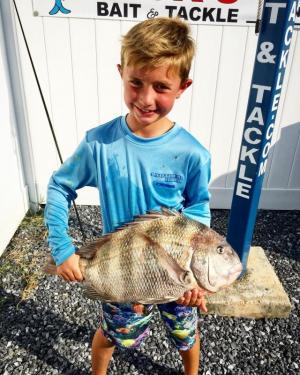Fishing has been pretty good on days when the wind hasn’t blown a gale.
The most productive action remains in the ocean, where boat limits of black sea bass continue to please charter, head and private boat owners alike. A few triggerfish and flounder have been taken along with the sea bass. Closer to shore, triggerfish and blues are found at Fenwick Shoal. The blues are caught on trolled spoons while the triggerfish will take bits of clam or whole sand fleas fished on one of the wrecks.
The reef sites in Delaware Bay are seeing good numbers of blues, croaker, triggerfish, kings, trout and blowfish. The real surprise all year has been the number of trout over the 13-inch minimum size and some that exceed the three-pound citation size. Peeler crab, clams, bloodworms or FishBite bloodworms have all accounted for some trout.
Triggerfish have been caught at the Outer Wall and the Ice Breakers. Here too, sand fleas and green crab have been the top baits.
The fishing pier at Cape Henlopen State Park has seen improved fishing for flounder since the beginning of the mullet run. Live mullet worked close to the pier pilings have produced keeper flounder as well as several shorts.
Cobia regulations
As nature abhors a vacuum, so a fisheries manager abhors an unregulated fishery. Cobia are a new species to the Delaware coast, having arrived in recent years as ocean temperatures increased and schools of menhaden supplied an enticement to the big fish. Delaware had no regulation for cobia, giving anglers and commercial watermen a free pass on whatever they caught. The federal government had closed cobia fishing in the Exclusive Economic Zone from three to 200 miles out.
Delaware’s Division of Fish and Wildlife has come up with two possible sets of cobia regulations. The first would allow cobia fishing all year with a 32-inch minimum size, a one-fish possession limit per person or per boat. The second would mirror the Virginia cobia regulation, which is a 40-inch minimum size, a one-fish-per-person or three-fish-per-boat possession limit, and a season that runs from June 1 to Sept. 15.
There will be a public hearing in Dover at some future date where fishermen can express their preference for one of the two regulations. Going by past attendance, I don’t expect a large turnout.
Striped bass
Speaking of poor attendance, there were only 13 members of the public at the recent Atlantic States Marine Fisheries Commission public hearing on striped bass in Dover, and at least seven of those were commercial watermen. The watermen spoke for the status quo option, no action, because there are plenty of striped bass, but that option has no chance of passing.
The public has until Monday, Oct. 7, at 5 p.m. to send their comments to Max Appleman, Atlantic States Marine Fisheries Commission, 1050 North Highland St. Suite 200A-N, Arlington, VA 22201. Or you can email comments@asmfc.org. Subject: Striped Bass Draft Addendum VI. I have used the email option.
I support Option 3, where the commercial sector takes a 1.8 percent reduction and the recreational sector takes a 20 percent reduction. The recreational sector is responsible for the vast majority of the mortality of the striped bass both from the fish retained and the fish released. Option 2 would tax both sectors with an 18 percent reduction, which I view as unfair to the commercial sector.
As for the regulations to comply with the 20 percent reduction, I would like to see sub-Option 3-A2: a 28- to 32-inch slot and a one-fish bag limit. I have long believed that a slot limit for striped bass would result in a recovered stock, as it did for red drum. The problem has always been educating the fishing public that catch-and-release of big stripers is equally as rewarding as killing them.
This regulation would apply to the ocean. There will be much bloodletting when it comes time for Maryland to decide on regulations for the Chesapeake Bay.
Some groups continue to push for making striped bass a sportfish with no commercial harvest. I have been and continue to remain opposed to this idea. Why should the only people who are allowed to eat striped bass be the ones who catch them on hook and line? That is simply ridiculous. If there are enough striped bass or any other fish for the recreational sector, then there are enough fish for the commercial sector.
Look what happened in New Jersey. They closed their commercial fishery on striped bass and then moved the commercial quota to the recreational side. That’s real conservation.
I hope at least one or two of you will take a few moments of your time to comment on the Striped Bass Draft Addendum VI. You can find it online by searching ASMFC Striped Bass Draft Addendum IV.

























































